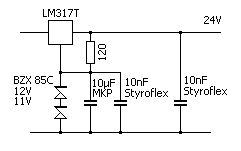|
Article
|
|
LM317, understanding and listening - July 2007
|
Last revision on July 2007
|
|
LM317, understanding and listening - July 2007, by Eric Juaneda
LM317 regulator is very popular device. It is present in most preamplifier or CD.
In this article I try many decoupling method and compare sound quality.
With regulator, we think at first noise rejection. The LM317 datasheets from National semiconductor
gives decoupling solution. What about sound and musicality?
For this tries, I use my model 3 preamplifier with following power supply.
|
|
|
|
Note: 1N4007 is very bad choice. Prefer fast rectifier diodes to prevent reverse current.
|
It is not easy to describe sound quality. For a comprehensive comparison, I use 8 categories.
- Softness,
- Tone realism,
- Dynamic,
- Definition,
- Bass level,
- Bass depth,
- Space clarity,
- Voice position.
|
|
First listening test
|
R1 = 240 Ohm, R2 = 4.3K Okm
 For this first test, I follow solution given in LM317 Datasheet.
For this first test, I follow solution given in LM317 Datasheet.
Cout = 1µF Wima MKS2
Cadj = 10µF Tantalum (while datasheet mention solid tantalum)
 Cout = no capacitor (risk of ringing!)
Cout = no capacitor (risk of ringing!)
Cadj = 10µF Tantalum
 Cout = 1µF Wima MKS2
Cout = 1µF Wima MKS2
Cadj = No capacitor
 Cout = no capacitor
Cout = no capacitor
Cadj = No capacitor
To achieve comparison, I use switches to compare solutions.
|
Comprehensives diagrams. Only given to understand which solution
sound better than another one. Diagrams are not drawing to scale. Do not compare between us.
Only comparatives values, no absolute values.
Note about listening test
|
|
|
|
|
|
|
|
|
|
|
|
|
|
|
|
|
|
|
|
|
First remarks
|
- Without capacitors LM317 sound good but still very noisy (16mV pp). see details
- Datasheet recommendations greatly reduce noise, but sound is deadly boring!
- Cout maintains stability while Cadj reduce noise.
- Incorrect capacitor's values sound bad and can cause ringing.
|
|
Second listening test
|
R1 = 240 Ohm, R2 = 4.3K Okm
 Cout = no capacitor
Cout = no capacitor
Cadj = 10nF styroflex
R1 = R1/2 (120 Ohm), R2 = R2/2 (2.2K Ohm)
 Cout = 4.7µF MKT + 22 Ohm
Cout = 4.7µF MKT + 22 Ohm
Cadj = no capacitor
R1 = R1/2 (120 Ohm), R2 = R2/2 (2.2K Ohm)
 Cout = no capacitor
Cout = no capacitor
Cadj = No capacitor
R1 = R1/2 (120 Ohm), R2 = R2/2 (2.2K Ohm)
 (Reference point, same values as first test)
(Reference point, same values as first test)
Cout = no capacitor
Cadj = no capacitor
 Cout = 4.7µF MKT + 22 Ohm
Cout = 4.7µF MKT + 22 Ohm
Cadj = no capacitor
|
|
|
|
|
|
|
|
|
|
|
|
|
|
|
|
|
|
|
|
|
Second remarks
|
- Driving LM317’s reference point by current gives good result.
- Decreasing Cout value, increase quality.
- Qualities of capacitors greatly change sound.
|
Conclusion
|
Driving LM317 reference point by current gives good result.
Taking care with capacitors technology is very important.
Even a little 10nF modify sound quality. Prefer polypropylene or polystyrene to ceramic or plastic capacitors.
You can adjust tonal balance by using different capacitors technology, polypropylene or polystyrene for soft sound,
ceramic or plastic for savage sound.
Use Cout as small as possible. Take care ringing with too small Cout value.
Here is an example of good subjective sounding solution.
|

|



